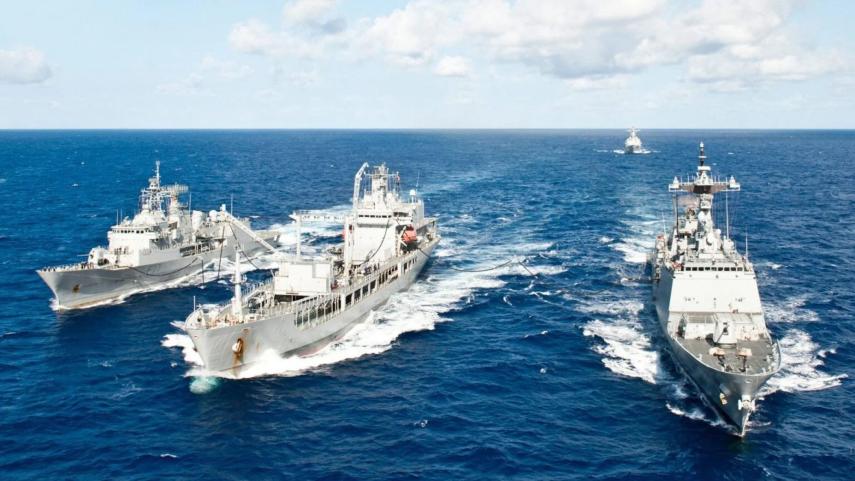Over the past decade, the US has worked to strengthen its strategic presence in Southeast Asia, both through NATO and regional partnerships.
There are several reasons for this 'strategic shift to Asia'. The growing economic importance of a region with "nearly half the world's population" residing there was one of them. China's rising power, its expansive maritime ambitions in the South China Sea and North Korea's nuclear programme, are other major drivers.
Under President Trump, tensions with China increased. His accusations of "unfair Chinese trade practices" led to a trade war. The main concern for the US is that China could assume the position of global leading economic power. These tensions manifested themselves in an increasing militarisation of relations in a region referred to as the 'Indo-Pacific' in several strategic documents under Trump's presidency. The US initiated several parallel strategic alliances at transatlantic and regional levels with the aim of curbing China's regional influence and consolidating the US position in the region economically and militarily.
China as NATO's "full-spectrum systemic rival"
In line with its prioritisation of China, Washington urged its NATO allies to become more aware of the Indo-Pacific. The NATO 2030 report -United for a new era - ordered by Stoltenberg to prepare a new strategic concept, described China as a "full-spectrum systemic rival", fostering an atmosphere reminiscent of a "new Cold War". Many NATO partners were ready to follow. Partly to keep the US on board NATO, but also because it fits into the growing international role for NATO in defending geopolitical interests. At the NATO summit in Madrid, heads of state and government approved a new strategic concept that for the first time mentions China's ambitions and policies as “a major challenge to NATO's security, interests and values”. It also addressed the growing cooperation between China and Russia, which NATO said threatened the established rules-based international order, ignoring its own behaviour in that regard. Although western sanctions resulted in that Sino-Russian cooperation, it proofed to be useful for the US in convincing European member states to take part in the Indo-pacific strategy, "given that developments in that region can directly affect Euro-Atlantic security" as it is written in the new Strategic Concept.
To emphasise that statement, the leaders of Australia, New Zealand, Japan and South Korea were invited to the last two NATO summits. At last year’s NATO summit in Vilnius, NATO formalised an enhanced cooperation with these four countries in various military fields. In the final declaration of the NATO summit China figured prominently as a threat. Beijing reacted sharply by accusing NATO of a cold war mentality.
However, due to the Russian invasion of Ukraine in February 2022, European NATO member states were increasingly obliged to focus their geostrategic attention mainly on Eastern Europe. Moreover, Europe being China's most important trading partner after ASEAN, is trying to balance economic interests with geostrategic tensions.
It caused the US to further pursue parallel multilateral and bilateral agreements with countries in the region. The Quadrilateral Security Dialogue - better known as the Quad - that the US concluded with Australia, India and Japan in 2007 was revived in 2017 - under Trump's presidency - to ensure a "free and open Indo-Pacific". It was followed in 2021 by AUKUS, a trilateral security pact between the UK, Australia and the US.
The American-Japanese-Korean Trilateral Pact
Last summer, the US initiated another regional strategic alliance, with Japan and South Korea, two countries that bear between them a history of difficult and strained relations rooted in Japan's 35-year occupation of the Korean peninsula from 1910 to 1945 on the issue of compensation of wartime forced labour, among others. With Japanese Prime Minister Fumio Kishida and South Korean President Yoon Suk Yeol taking office, relations between the two countries have greatly improved. For the US, that was the moment to strengthen strategic ties between and with these countries.
On 18 August, they concluded an American-Japanese-Korean Trilateral Pact (JAROKUS) at Camp David. The purpose of the agreement is to set up a Hot-line for consultations during times of crises, to have regular trilateral military exercises and an annual summit. For South Korea and Japan, the nuclear threat posed by North Korea is a key motivation. North Korea sees intensifying military cooperation between the three countries as a major threat, providing additional motivation to further strengthen its nuclear programme. In April 2023, the US and South Korea already signed a declaration for a US extended deterrence commitment against threats from North Korea. Japan in turn decided last year to double its military spending over the next 5 years up to 2% of its GDP. The current trilateral agreement provides for regular joint manoeuvres - called 'invasion rehearsals' by North Korean leader Kim Jong Un - and an annual summit. The first summit was in January 2024 where not only the threat of North Korea was discussed but also “the dangerous and escalatory behaviour” of China. It will likely contribute to greater military cooperation between North Korea, China and Russia. The latter two countries have already intensified their joint air and sea exercises.
The US-policy seems to be an important driving force of a dangerous militarisation of the region which has increased the likelihood of a nuclear confrontation in opposition to what countries really need: dialogue, diplomacy, disarmament and confidence-building measures.
